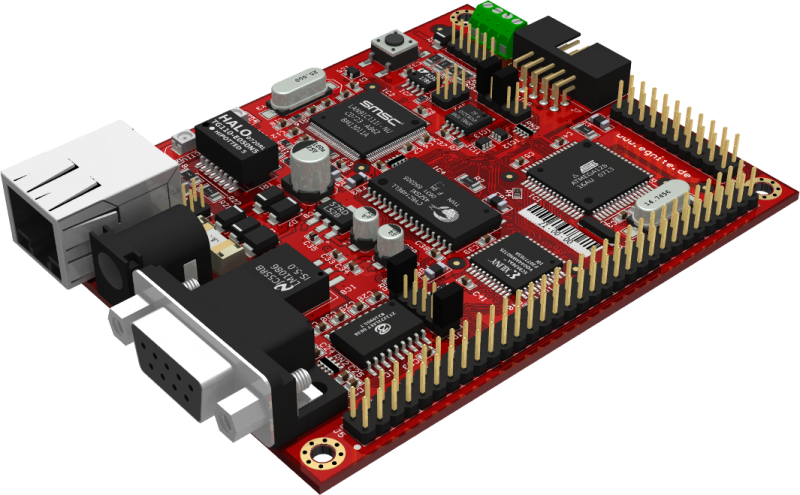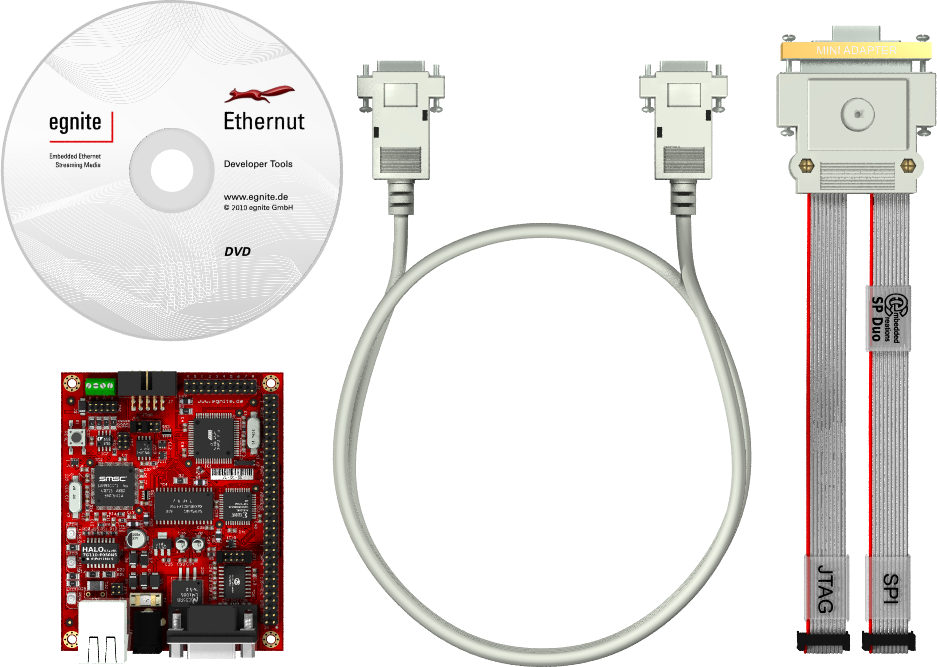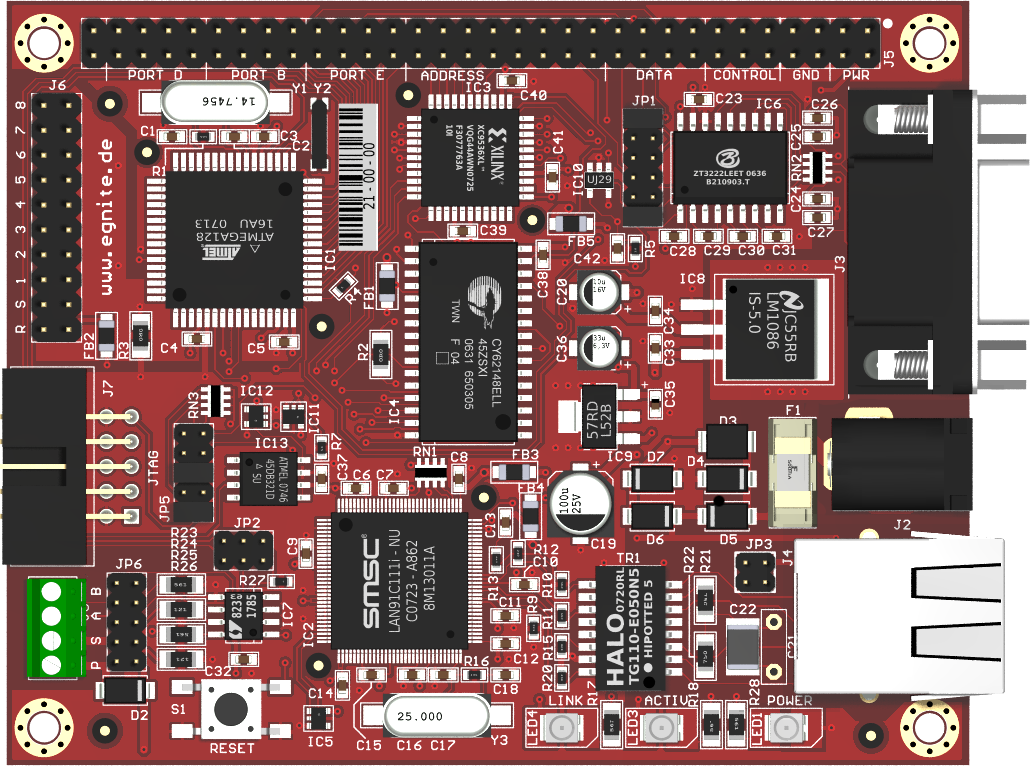Ethernut 2

SBC FOR INDUSTRIAL APPLICATIONS
Hardware
Atmel’s AVR microcontrollers guarantee fast code execution combined with the lowest possible power consumption. Ethernut 2.1 is a single board computer with an extended temperature range, which integrates the 8-bit AVR ATmega128 into an Ethernet network.
In addition to 100 Mbit Ethernet, the board offers a larger memory than its predecessor, Ethernut 1. With the extra RS-485 interface and the extended temperature range from -40 to 85 °C, Ethernut 2.1 is predestined for industrial applications.
Like all other Ethernut boards, it provides an extension connector for attaching additional hardware. Hence it is suitable for both the prototyping of your own hardware as well as for direct integration into your finished product.
Ethernut boards come in use where robustness, reliabilty and long-term availability play a vital role. Our in-house quality control procedures guarantee a consistently high level of reliability.
The main characteristics of Ethernut 2.1 boards are:
- Low power, high performance RISC CPU
- 128 kByte Flash memory and 512 kByte bank-switched RAM
- Memory mapped Ethernet controller with 100BASE-T connector
- RS-232 and RS-485 connector to control and monitor external devices
- Expansion port with 20 digital 5V I/O ports, including counter I/O, USART, SPI, I2C or PWM
- 8 inputs to monitor analog values
- Memory expansion bus
- JTAG connector for programming and debugging
- Industrial grade temperature range
- Single 9-12 V power supply
Software
Application development is carried out in the high level programming language C, using either free GNU tools or the commercially supported ImageCraft compiler.
An active Open Source community developed and managed Nut/OS, a cooperative multithreading operating system with TCP/IP stack, which was specially designed with tiny embedded systems in mind. The well documented source code provides a convenient user interface, which is very similar to the C programming of desktop PC’s. Programmers will therefore quickly feel at ease operating this.
Although pre-configured for Ethernut 2.1, all important settings can be customized with just a few mouse clicks with an easy to use graphical interface available on Linux, Windows and Mac OS X PCs incorporating any special requirements. A complete Internet enabled web server needs less than 60 kByte Flash and 12 kByte RAM. This leaves enough space for ambitious product ideas, including a boot loader for the update of firmware via the network. Many useful example applications are included in the distribution.
Licence
The entire source code for the target system, as well as the hardware design, have a permissive BSD licence. This is available for commercial products without any licence fees.
In contrast to some other Open Source licence models, there is no obligation to publish your own source code enhancements.
Specifications
| Processor | |
| CPU | ATmega128-16AU, 14.7456 MHz clock |
| Flash memory | Internal 128 kByte |
| EEPROM | Internal 4 kByte |
| Static RAM | External 512 kByte |
| Serial Flash | External 512 kByte |
| RTC | Software with 32.768 kHz crystal |
| Interfaces | |
| Ethernet | RJ-45 10/100Base-T (LAN91C111) |
| RS-232 | 1 x 9-pin DCE, 4-Wire |
| RS-485 | Half duplex |
| Digital I/O | 20 configurable GPIO lines with alternate functions |
| Analog I/O | 10-bit ADC, 8 multiplexed inputs with alternate functions |
| Programming | 10-pin JTAG |
| Indicators | Power (red), link (yellow), activity (green) |
| Power Supply | |
| Regulator | Linear 1.5 A LDO (LM1086) |
| Input | 2.1 mm barrel connector, unregulated 9 V to 12 V DC |
| Expansion port | 9 V to 12 V unregulated or 5 V regulated, output > 3 W |
| Consumption | < 2 W at 9 V |
| Battery backup | None |
| Protection | |
| RS-232 | 15 kV ESD protection |
| RS-485 | 15 kV ESD protection |
| Ethernet | Transformer isolation |
| Power supply | 1 A replaceable fuse, rectifier Bridge, current limiter, thermal shutdown |
| Environmental | |
| Operating temperature | -40°C to 80°C (-40°F to 176°F) |
| Storage temperature | -65°C to 140°C (-85°F to 284°F) |
| Humidity | 5% to 95% non-condensing |
| Approvals | |
| Immunity | EN 61000-6-1:2001 |
| EN 61000-6-2:2001 | |
| Emission | EN 61000-6-3:2001 |
| EN 61000-6-4:2001 | |
| Safety | PCB flammability rating UL94-V-0 |
| RoHS compliance | EU directive 2002/95/EC |
| Metrics | |
| Dimensions (L x W x H) | 98 x 78 x 17 mm (3.86 x 3.07 x 0.67 in) |
| Weight | 64 g (0.141 lb) |
| Product identification | |
| PCB revision | Written in copper on the PCB's backside |
| Serial number | IEEE registered MAC Address on barcode sticker label (Code 128C) |
Ethernut 2 Support
Ethernut 2.1 is shipped with a pre-installed application called Basemon, that performs a self test and provides a small webserver. How to put Ethernut 2.1 into operation, first steps with Basemon, as well as error handling, are described in the Ethernut 2.1 Hardware Manual.
To develop applications in Nut/OS, you should start reading Nut/OS on Ethernut 2, which explains how to configure and set up Nut/OS. The software manual describes the basic procedures of Nut/OS development. A detailed description of all Nut/OS functions can be found in the Online Reference API. The NutWiki provides an extensive collection of example code as well as further resources for developers.
All available documentation can be found on the Ethernut 2 page on ethernut.de.
Documentation
Ethernut 2.1 128 flyer
21.04.2011 | 0.56 MB | English
Ethernut 2.1 Quick start guide for Windows 1.0
22.08.2010 | 0.62 MB | English
Ethernut 2.1 128 Hardware Manual
3.39 MB | English
Change notice 2.1B
23.09.2009 | 0.18 MB | English
NutWiki
The NutWiki offers programming resources for Nut/OS
Nut/OS Online Api
Online API reference for Nut/OS
Nut/OS Software Manual
This document explains how to setup and use Nut/OS
Software und Tools
Nut/OS for Windows
Executable installation for Windows PCs.
Nut/OS for Linux and Mac OS X
Source code package for manual installation on Linux and Mac OS X.
Application Examples
Nut/OS Examples
The NutWiki provides a multitude of programming examples for Nut/OS


